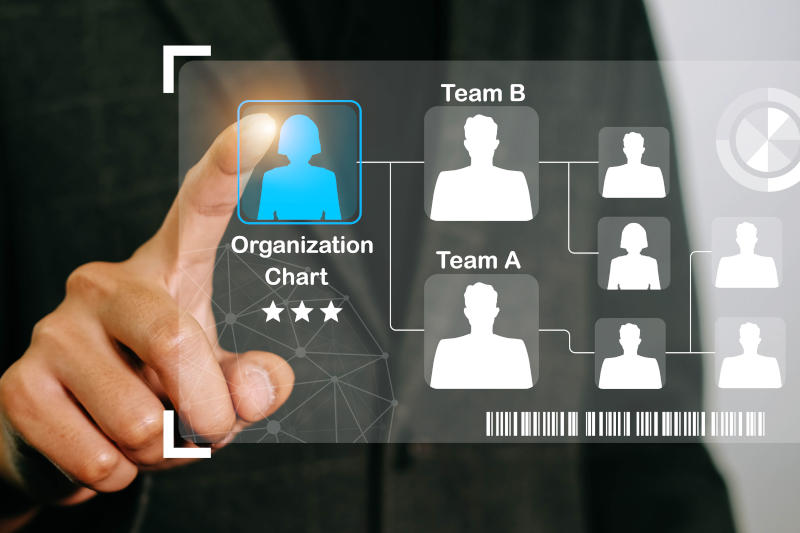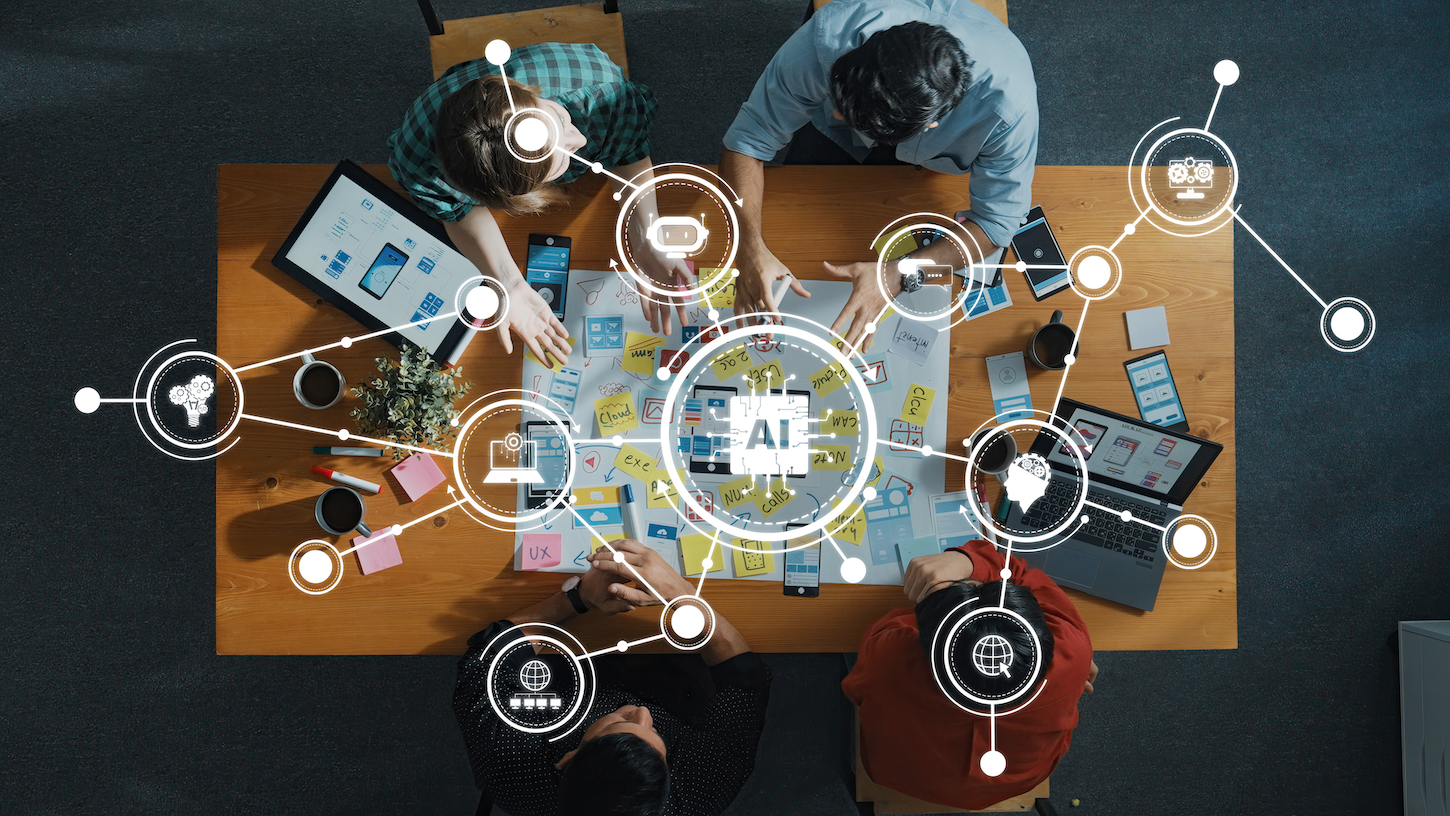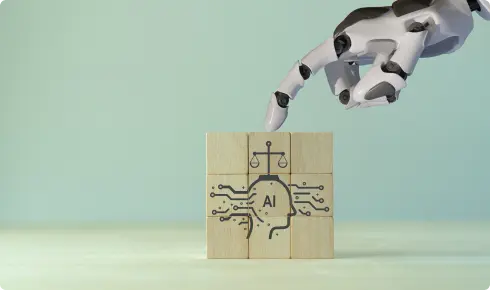
by Faisal Hoque, Pranay Sanklecha, Paul Scade
Fears that AI will dehumanize work overlook its potential to make organizations more human. Here’s how organizations can harness the power of human-centered AI.
The prevailing view of AI is that, while it promises to deliver enormous efficiency gains, it also threatens to dehumanize work and commerce. While these concerns deserve to be taken seriously, the counterintuitive truth is that AI systems can make organizations more intensely and accessibly human. Rather than stripping away the personal touch, AI can amplify the very qualities that make human interaction valuable: empathy, understanding, and the ability to connect across differences.

However, AI can also be used to enhance and elevate, rather than replace, human qualities.
It’s not AI vs humanity – one enhances the other
We cannot afford to be complacent about AI. The technology is too powerful, and it is undeniable that it does threaten human participation in the workforce. However, AI can also be used to enhance and elevate, rather than replace, human qualities. And it can do so in a way that can deliver significant business advantages. This nexus of human and machine capabilities should be the focal point of attention for forward-thinking CEOs.
This isn’t a consolation prize for leaders who can’t bring themselves to squeeze every last drop of humanity out of their businesses. On the contrary, this kind of human-centered approach is essential for delivering value in a world in which humans consume services, buy goods, and generally drive economic activity. AI can help push humanity and the best features of humans to the forefront of business operations, thus creating competitive advantages that are absent from purely efficiency-focused approaches.

Three key areas for AI deployment
In this context, there are three areas where AI can help organizations bridge cultural gaps and transcend operational constraints by focusing on amplifying human qualities. The following three brief cases illustrate how AI can:
- Scale empathy in customer interactions
- Dissolve knowledge silos within organizations
- Support service delivery across linguistic and cultural boundaries
The pattern that emerges from these examples is clear: AI is at its most powerful not when it replaces humans but when it amplifies human connection.
1] Scaling empathy by bridging interpersonal divides
Many organizations build their service models to optimize cost efficiency and maximize throughput. Hitting these targets often means using strategies that consumers have come to dread: offshoring contact centers or replacing humans entirely with automated systems. Over time, this kind of approach reshapes both organizational culture and customer expectations, making empathy feel like a luxury rather than a standard. The consequences of these attitude shifts are very real: according to TCN’s 2024 survey, nearly two-thirds (63%) of Americans say they’re likely to abandon a brand after a single poor service experience – a nearly 50% increase over the past four years. At the same time, consumer expectations for empathy and responsiveness are rising. In most narratives about “the rise of the machines,” AI is the villain in these kinds of situations, responsible for accelerating the move away from empathy and connection. Yet the truth is that, when AI is implemented thoughtfully, it can help bridge this gap by supporting warmer and more personalized customer experiences.
Here are two live examples of how AI can boost rather than dilute feelings of empathy and connection.
AI can be unexpectedly effective at scaling empathy even in high-stakes settings like healthcare. The shift towards a “digital front door” for healthcare encounters in the US presents physicians with an enormous challenge: tens of thousands of patient messages arriving via Electronic Health Record inboxes every day. Many require responses that not only contain medically accurate information but that are also emotionally nuanced. A recent study from NYU found that AI-generated responses to patient messages were rated as more empathetic than those written by physicians, scoring higher on warmth, tone, and relational language. While not always as clinically precise, the AI replies were more likely to convey positivity and build connections. This suggests a powerful new role for generative tools. Instead of impersonal templated responses or terse replies from overburdened healthcare providers, AI can deliver personalized responses, relieving cognitive load on doctors while reinforcing a culture of compassion.
AI-powered contact center platforms like Genesys provide agents with on-screen hints about customer tone, journey stage, and emotional context as a call unfolds, then suggest phrasing for responses. On the surface, this is a technical solution to improve efficiency and global staffing flexibility. But its deeper value lies in its ability to help humans tailor responses to provide personalized customer engagement, thus scaling the emotional intelligence embedded in their customer interactions.

The larger an organization gets, the harder it is to keep everyone connected, informed, and on the same page.
2] Scaling individual capabilities by bridging organizational gaps
Many organizations struggle with inefficiencies that are rooted in intra-departmental skill gaps and knowledge silos. When your engineering team can’t articulate the project’s business case and your product managers don’t understand the technical constraints you’re facing, projects stall, sales are lost, and innovation opportunities go to waste. Obstacles like these typically emerge when different parts of an enterprise develop their own languages, priorities, and ways of working.
AI can now act as a cognitive exoskeleton that augments employee knowledge by delivering contextually relevant information.
The larger an organization gets, the harder it is to keep everyone connected, informed, and on the same page. But AI offers a whole suite of new tools that can help overcome these barriers. AI can now act as a cognitive exoskeleton that augments employee knowledge by delivering contextually relevant information and personalized training as needed. The ability to pull information across boundaries and then instantly repackage and recontextualize it to meet individual needs creates a two-way bridge across silos.
These two real-world examples are already transforming how organizations operate.
- The author team’s US defense contractor partner, CACI, an $8bn Fortune 500 company, has developed and implemented a generative AI hub that audits each new planning document for cultural fit and organizational alignment. By centralizing data at the whole-enterprise level, and then using this composite construct as a reference point for each document, local blind spots, misunderstandings, and divergent threads can proactively be identified and corrected before a project goes live.
- Cornerstone’s learning platform connects employees to bite-sized lessons that can be drawn from any internal file across the enterprise. This turns previously static knowledge into personalized, on-demand learning. Rather than relying on formal training alone, the platform embeds contextual support directly into daily workflows. When combined with real-time labor market intelligence, these kinds of AI tools can also help organizations rapidly identify skill gaps, support cross-functional mobility, and adapt workforce strategies.

For companies expanding into new markets, access is often limited not by infrastructure or cost but by barriers to communication.
3] Scaling market reach by bridging cultural gaps
For companies expanding into new markets, access is often limited not by infrastructure or cost but by barriers to communication. Cultural norms, language differences, and digital fluency can become obstacles to the smooth delivery of services. The challenge for businesses is finding ways to overcome these barriers without duplicating capabilities for each cultural group. AI now offers a range of tools for navigating this kind of cultural complexity at speed and scale.
Here’s a powerful example of how AI can help overcome barriers to market entry while connecting humans with services that would not otherwise be available to them.
- Language diversity and low literacy levels in emerging markets are classic examples of barriers to market entry. Nigeria alone has more than 500 native languages and more than 100 million potential customers who do not speak English, the official language. India has more than 1,500 languages and hundreds of millions who speak neither English nor Hindi. Serving these populations with traditional tools would require separate teams, scripts, and platforms for each language – making broad service access operationally untenable. But by leveraging AI, companies can bridge these cultural gaps by scaling the ways customers can access their services.
In India, companies are beginning to adapt chatbot and voice systems to accommodate linguistic diversity. In Africa, telecom leaders like Orange are partnering with companies like Meta and OpenAI to overcome similar problems. This trend reflects a growing recognition that long-term market growth depends on embedding cultural specificity at the infrastructure level. Multimodal AI models trained on low-resource languages allow service providers to connect directly with people in underserved groups who can neither read nor type fluently in dominant national languages. Voice bots that read forms aloud, answer in local idioms, and hand off to human reps only for edge cases will slash call center costs and raise customer intimacy.
Three pillars of AI deployment
CEOs wanting to make the most of this cooperative link between AI and a human-centric approach can start with three basic steps, which, if followed thoroughly, will set the organization on a positive track to success.
- Designate a cross-functional GenAI knowledge broker. Nominate one tech lead and one business lead. Give them a 30-day brief to map your richest data silos and prototype a retrieval-augmented chatbot capable of sharing and contextualizing information across existing organizational boundaries.
- Insert AI coaching into one frontline workflow. Deploy real-time sentiment cues and autogenerated call summaries for agents, track handle time, transfers, and engagement scores.
- Publish a one-page ‘AI Empathy Charter’ prioritizing the use of AI in contexts that promote human connection and empathy. Develop principles for ensuring transparency, cultural inclusivity, and data privacy.
Original article @ IMD.















